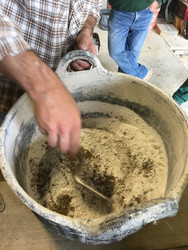What is Hotlime
Posted by Ian, Celtic Sustainables on 10th Aug 2018
Ok first the science bit.
If you burn Limestone (calcium carbonate) in a kiln at high enough temperatures, the water and CO2 are driven out, creating Quicklime (Calcium Oxide). Adding water to (Slaking) the Quicklime creates hydrated lime (Calcium Hydroxide). If the hydrated lime is mixed into a mortar and left to dry, it will cure, reabsorbing CO2 and returning to its original state (Calcium Carbonate). This process is known as ‘The Lime Cycle’.
So, to help explain the hot-lime mortar making process, we need to go back to the slaking part of the limecycle where water is added to the crushed quicklime and a rather impressive chemical reaction occurs producing dangerous amounts of bucket melting heat, while the quicklime doubles in volume.
The finished product from slaking process is a lime putty which is often matured and then used at a later date. The matured lime putty is then mixed with sand to create a lime mortar or with water to create a limewash.
The hotlime process combines the slaking and the mortar making process together.
The quicklime from the kiln is crushed to a powder and then added to the sand. Water is then added to the dry mix and the processes of slaking and mortar creation happen simultaneously. The resulting mortar is warm, creamy and very sticky.
You can also create a limewash from quicklime. Add water to the quicklime to trigger the slaking process and then if necessary add extra water to create a solution which is milk-like in consistency.
NOTE: For those of us who don’t have a lime kiln, quicklime is available as a ready crushed powder. I recommend Calbux90 which is made from pure white Buxton limestone. Handle with care though if it gets wet it will set of a reaction which can be dangerous if uncontrolled.
Safety considerations.
As I’ve already mentioned, Quicklime can be dangerous! Adding water to quicklime creates a chemical reaction that generates a lot of heat, lime is also very alkaline and can burn skin. Safety precautions must be taken including the wearing of gloves and eye protection. Clothing that covers arms and legs, is also recommended to protect skin from any splashing. Even after the slaking process has finished, care should be taken as lime is very alkaline and can burn.
And finally – some food for thought
We’ve already established that quicklime doubles in volume when water is added. So, if a dry hotlime mix starts as a 3:1 ratio it’s actually going to end up as a 3:2 mix when the water is added. So it is worth considering that if historical records for lime mixes are actually for hot-lime mixes (which is likely) they would have been twice as strong as the equivalent NHL or Lime putty mortars often mixed today.


